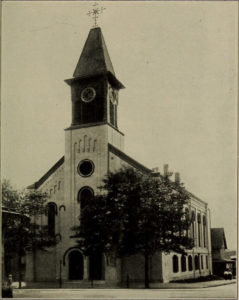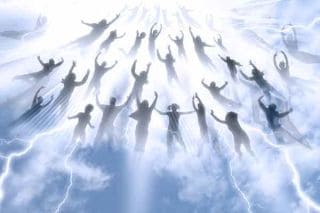Two Separate Raptures Are What Cause All The Confusion
1) Firstfruits 144,000 who receive the seed of Jesus, then mature and ripen before all other followers of Jesus. They become The Bride of Christ.
2) 3.5 years later, after the church has matured due to the heat and pressure of the Tribulation.
An Excerpt from The Last Times and the Great Consummation:
An earnest Discussion of Momentous Themes c 1863
By Joseph A. Seiss, D.D.
 Dr. Seiss pastored the Church of the Holy Communion in Philadelphia, Pa, in the mid to late 1800’s. His style of writing may not allow for the modern reader to follow as clearly, however none of his original wording has been changed.
Dr. Seiss pastored the Church of the Holy Communion in Philadelphia, Pa, in the mid to late 1800’s. His style of writing may not allow for the modern reader to follow as clearly, however none of his original wording has been changed.
The opinion that there is to be a duality in the translation of the saints ( as also in the resurrection of them that sleep in Christ) seems to me to have strong supports in the Scriptures.
1. In the description of the great woes which are to attend the close of the present dispensation there is a command given to “watch and pray always,” that we “may be accounted worthy to escape all these things that shall come to pass, and to stand before the Son of man.” It is here implied that there will be Persons living when these troubles come, who, by peculiar earnestness in their expectancy of the Lord’s return shall obtain entire exemption from them; and that this exemption will consist in some peculiar introduction into the immediate presence of the Son of man, that is, by being caught up to him in the clouds. Something of the same sort is intimated in Isaiah 26:20, where God’s peculiar people are represented as called up into some peaceful pavilion, where they are at rest while the waves of divine indignation are rolling over the world. But in Revelation 7:9-14 we read of a great multitude of the redeemed who are represented as having had to suffer these very woes, and as having reached heaven through them. It is specifically said, “These are they which came out of the great tribulation, ” – not out of tribulation in general, but some specific and preeminent tribulation – “out of the tribulation, the great one” – which we find described in Daniel 9:27, 12:1; Matthew 24:21-22; Luke 21:24. Now, as some are accounted worthy to escape these things, and escape by their removal to the presence of Christ, and as others only reach their places before the throne of God by passing throughout the \Great Tribulation, there must needs be two stages in the removal of the Church, that is , two distinct translations.
 2 Again, in Revelation 14:1-5, we read of a certain number of the “redeemed from among men,” who have reached the heavenly state in the presence of the Lamb, and who are called “the first fruits unto God.” There is a difference between the first fruits and the general harvest, not exactly in kind, but in the order of their gathering, and in the purposes to which they are applied. There is always an interval between the gathering and lifting up of the one, and the general reaping of the other. And, answering in this respect to the first fruits described in the first part of the chapter, we have an account of the reaping of the great harvest in a subsequent part (vss 15-16). Those that constitute the first fruits, of course, cannot be the same as those who constitute the general harvest. The one is a distinct class from the other, and is separated from it especially as to the precise time of the gathering, whilst, nevertheless, the gathering is of the same kind in both. And as both classes are made up of persons redeemed from among men, and “caught up in the clouds to meet the Lord in the air,” we must conclude that there is to be a twofold translation.
2 Again, in Revelation 14:1-5, we read of a certain number of the “redeemed from among men,” who have reached the heavenly state in the presence of the Lamb, and who are called “the first fruits unto God.” There is a difference between the first fruits and the general harvest, not exactly in kind, but in the order of their gathering, and in the purposes to which they are applied. There is always an interval between the gathering and lifting up of the one, and the general reaping of the other. And, answering in this respect to the first fruits described in the first part of the chapter, we have an account of the reaping of the great harvest in a subsequent part (vss 15-16). Those that constitute the first fruits, of course, cannot be the same as those who constitute the general harvest. The one is a distinct class from the other, and is separated from it especially as to the precise time of the gathering, whilst, nevertheless, the gathering is of the same kind in both. And as both classes are made up of persons redeemed from among men, and “caught up in the clouds to meet the Lord in the air,” we must conclude that there is to be a twofold translation.
3. There seems also to be an intimation that even Christ’s coming is to possess two distinct stages – which would again correspond with the idea of a twofold translation. He is to come “as a thief in the night”; but He is also to come “in the clouds of heaven, with power and great glory, ” “taking vengeance on them that know not God,” and to be admired in all them that believe.” In the one case He is seemingly invisible, removing as by stealth those who are waiting and ready, and fulfilling those words of His, “in that night there shall be taken and the other left,” etc. In the other case, “every eye shall see Him,” and He rides forth upon His celestial chariot as a mighty conqueror, crushing down before Him all His foes both great and small, and gathering to Himself the great totality of them that believe on His name. Both these comings, or stages of His manifestation, cannot occur at one and the same time, and so would involve a twofold translation.
4. To this also agrees the account given in Matthew 24:42-51; where we read of a servant who is “faithful and wise,” whom his Lord finds at his post, and at once receives to blessedness; but also of another servant, as really a servant as the first, who is deficient in fidelity and worldly in his temper, and who his Lord when He comes severely punishes by assigning him a portion with hypocrites, who are to suffer the Great Tribulation. The words do not at all imply that the one is saved and the other lost, but simply that the one reaches blessedness at once when the Lord comes, whilst the other, not being prepared by proper watchfulness, is “left”, and punished with such temporal judgments as are then to befall the earth, and only saved “so as by fire” at a subsequent period.
5. So, too, the parable of the ten virgins (Matt 25:1-13). Those virgins are the whole company of the saints, and are all true Christians and real believers; but only a portion of them go in with Christ to the marriage, whilst the rest are “left” to improve their virtues under the afflictions attending a loss of their place among the first fruits and Church of the firstborn, and to receive their redemption at some later stage of the Savior’s manifestation.
6. So, too, in the parable of the pounds (Lk 19:11-27), we have some faithful and industrious servants who improve their trusts well, and who when the Lord returns are at once welcomed into the sublime rewards of their exertions. But there is another class, so timid and unfruitful in their occupancy that, when the Lord comes, they are not honored as the others, but stripped of the trusts they had received, and left to suffer for their unfaithfulness. They are not lost. They are not slain, as the malignant “citizens” who would not acknowledge Christ’s rule over them. They simply lose their rewards, and their places among those who obtain rulership, and are made to endure the Tribulation judgements.
7. To the same effect is the twelfth chapter of Revelation. We there read of “the woman’s seed, which may be taken first as Christ Himself, but, for that reason, as the whole body of His people upon earth. In verse 5, this seed, as intended to “rule the nations,” is represented as “caught up unto God, and to His throne.” Here, then, is one ascension. But in verse 17 we still read of a “remnant” – a remaining portion of this same woman’s seed, which must certainly denote Christian people; for they are such as “keep the commandments of God, and have the testimony of Jesus Christ,” and are still upon earth suffering the dragon’s wrath. And as all must needs be glorified in due time, there must be a second translation to embrace these. They suffer additional persecutions to their brethren, and so are not taken at the same time with them, but are saved only by passing through the Great Tribulation, which the more devout and watchful escape by means of an earlier translation. Compare also Matthew 24:28,31; and Luke 17:34,37.
8. The fourth and fifth chapters of Revelation also evidence the same thing. A scene in heaven is there depicted. The elders and living creatures in that vision must represent saints in the glorified state. They address a song to Christ, in which they say to Him, “You were slain, and have redeemed us to God by your blood.” We know of no redeemed by Christ’s blood but men. They were not, therefore, heavenly orders or angels proper, but ransomed human beings from the earth. Nor were they the saints who rose with Christ; for those appear to have been Jew: these are “out of every kindred, and tongue, and people, and nation.” They are also already “kings and priests,” and have their crowns,” – which could not be said of the saints of the old dispensation, for they have not yet received the promises. The coronation time is at the coming and consummation (Heb 11:13, 40; 2 Tim 4:8; 1 Pet 1:4, Col 3:4). The vision must, therefore, refer to a state of things in the heavenly state of the glorified saints in connection with what is said in 1 Thess 4:17. It is remarkable, however, that whilst these are in the heavenly glorified state, and have already received their crowns, the preliminary judgments of the seals are only about to begin. And as the Great Tribulation occurs only in connection with the opening of these seals, the =translation by which they are brought to their rewards must precede the Great Tribulation; whilst, according to Matthew 24:29-31, there is another gathering of the elect “immediately after the tribulation”; thus making two stages in the translation. Compare Psalms 27:5-6, 31:20, 32:6-7, 45:14. The doctrine of the Scriptures seems to be, that only those who are devoutly looking and waiting for the Savior’s return shall be taken at first, whilst all others are left to suffer the Great Tribulation, which will continue at least three years and a half. See Hebrews 9:28; and Revelation 12:13-14, 15:5, 11:3.
Also, one of the best writings I have seen on the subject is the AMAZING little booklet by Leland Earls – The Three Comings of Jesus 1. Jesus Coming TO the Church. 2. Jesus Coming WITH the church. 3. Jesus Coming FOR the church. You’ll LOVE it!!!
Orthodoxy wants you to remain confused, and scared. We are all born into the matrix of lies and deceit. We must UNLEARN what we have been taught by replacing DEFECTIVE “truth” with BETTER TRUTH. Truer truth.
Russell Dibird


I concur with a good deal of what this author has to say…I wrote something myself some years back that is parallel to what he has to say…but, it just explains the harvest festivals & end times a bit differently….maybe you will enjoy the perspective….I need to update it however & change some things as I no longer believe in the teachings of Paul…I might not have it all together, but we are all work in progress…
https://newgenesisconnection.wordpress.com/2015/01/26/is-there-a-rapture-the-truth/
God Bless
***”In order of their gathering, and the purpose to which they are applied.” Exactly! Well said, that’s it precisely…
**I agree with him in this 2-fold interpretation, and the his positing of a two-phase manifestation–translation of His Coming. This adds yet another layer of intrigue to your work sir, and i mean that in a good way!
In 8. He makes a very pertinent point concerning the actual “person-hood” of certain entities in Heaven! And this raises a good line of questioning: Is Jesus the ONLY one whom will “come again?” I know you know the answer to this, as you have made certain statements that show it. What I mean to say is that your readers will, hopefully, hereby be suggested to think about it…
I like your ranging of supportive evidence, now how about EXTERNAL evidence here??? The analysis of Biblically scripture is excellent, now how about the non-Biblical??? just a suggestion to help speak to those “whom DO NOT (YET) have the eyes to see nor the ears to hear.” You know what I mean? Let the net widen a bit to reach more, and those whom will be stigmatized by so much internally exclusive doctrine… What think you?
This chapter is well received. Not a lot more to comment upon, given the self-evident nature of its material. I would also say that HOW His Several phase comings occur will also be of great import. In what ways shall He manifest Himself, and to whom, and where, when, etc.>??? Yes, I know, IN EVERY WAY, and I agree… Yet and still, it may be beneficial to contemplate this… For even the events of men may well be part of these comings… “Natural” events upon the global stage and such may well be so many workings of His in preparation for, or actualization of these comings… Given the proper amount of thought, this chapter is more important in the series than many will, at first or second glance/read, deem..